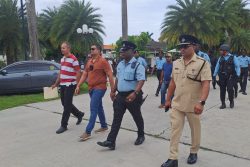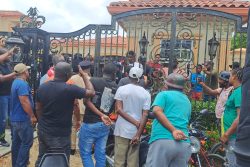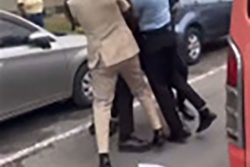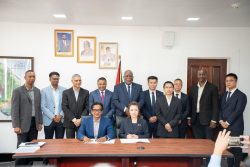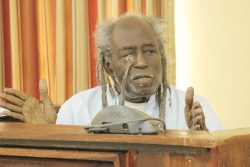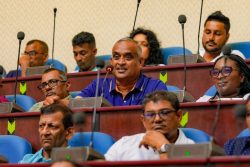The Customs Anti-Narcotics Unit (CANU) has now been called in to investigate how five bags of cocaine got in a container of logs on a ship that left Guyana last week but sources say there is little hope of it yielding any results as too much time has already elapsed.
It has been a week since the Jamaican authorities busted the 122.65 kgs of cocaine with a street value of $700 million among timber in a container on the MV Vega Azurit and just the shipping documents were handed over to CANU authorities with nothing else for investigators to lead off with.
One day after the bust, Commissioner of the Guyana Revenue Authority (GRA) Khurshid Sattaur said preliminary investigations had revealed that the Customs and Trade Administration (CTA) officers were vigilant and diligent in the execution of their duties but that the container with the cocaine was not subjected to a customs search. He had stated that customs procedures in this case were well tested and questioned how the container could enter a ship when it was not booked on the shipping record.
But sources last evening said it was highly unlikely that a container would have been allowed to leave Guyana on a ship without someone from customs being aware and it was pointed out that if there was no record of the container then there needs to be an investigation as to why this is so. “CANU has just been handed the shipping documents… nothing else. One week after the drugs was busted just the bare shipping documents, no record of what customs has been doing since the bust was made,” one source told this newspaper.
Stabroek News understands that while the Guyana Forestry Commission (GFC)–whose officers would have cleared that logs that were in the container before they were packed–has handed over a report of its investigation since the bust to CANU officials there has been none from the GRA, even though Sattaur had said a preliminary investigation was launched.
This newspaper was told that by now GRA should have had an idea as to what transpired and this should have been shared with CANU.
CANU officials do not have anyone in custody even though customs officials had arrested the alleged shipper of the log and questioned him, despite the fact that customs can only lay charges with regard to tax evasion and not narcotic related offences.
Sources said that while CANU would have to question him, the shipper can say that he was not there when the container was sealed, which is why the initial information gathered by GRA is important to the investigation.
This recent drug bust and the seeming bungling of the investigation, sources have said, begs the question as to why CANU ranks were removed from the wharves and why the checking of incoming and outgoing vessels became the responsibility of customs officers.
Reports are that the vessel on which the drugs were found left from the John Fernandes Wharf.
It had arrived in Guyana on March 11 and left the following day.
GFC’s investigation has since found that the container in which the drugs were found was switched to the MV Vega Azurit, after being originally booked to leave these shores on another ship.
The GFC checked the documents, which were then submitted to the shipping company and the CTA, and the vessel’s name listed on the form was changed from the MV Stadt Rotenburg to the MV Vega Azurit. Since the bust, the GFC learnt from the Jamaican authorities that the cocaine was found in the container with number ZCSU 8316084, which was then traced to the John Fernandes Wharf and which was shipped by ZIM Integrated Shipping Services Ltd and confirmed as being shipped on MV Vega Azurit on March 12. “This container number was listed on export documents covering a shipment of logs by the Aroaima Forest Producers Association (AFAPA) Export Licence BER 05602011 which was slated for shipment via MV Stadt Rotenburg,” the GFC’s head James Singh had said in a letter last weekend.
The letter had added that the produce was graded and inspected in Aroaima and a GFC Grading Inspector signed off the Timber Marketing Certificate (TMC) document on February 18, stating that 180 pieces of logs were inspected. The Aroaima Company on February 25 applied to the GFC for an export certificate to export 130 pieces of the already inspected 180 logs.
Sattaur Monday said that only a detailed investigation could identify at what point the cocaine was placed in the container. “…The logs and the containers were handled by several persons and agencies starting with the exporters and ultimately ending with the shippers. A breach could have taken place at any point in that
chain and only a detailed investigation would identify at what point the cocaine was placed in the container,” Sattaur said in a statement.
The statement said the GRA had called for a proper and detailed investigation into the March 12 bust and added that recent suggestions that officers from the CTA may be implicated “are at best premature since preliminary investigations conducted separately by the GRA and the GFC point to several discrepancies in the way the shipment of the logs was handled at different times by different agencies.”
